The Art Detective
Shoptalk: Legendary New York Art Dealer Paula Cooper Opens Up About Her Path to Power
'I was dying to work for a gallery. But I had no experience, and I was very shy. The only thing I knew how to do was operate a switchboard.'
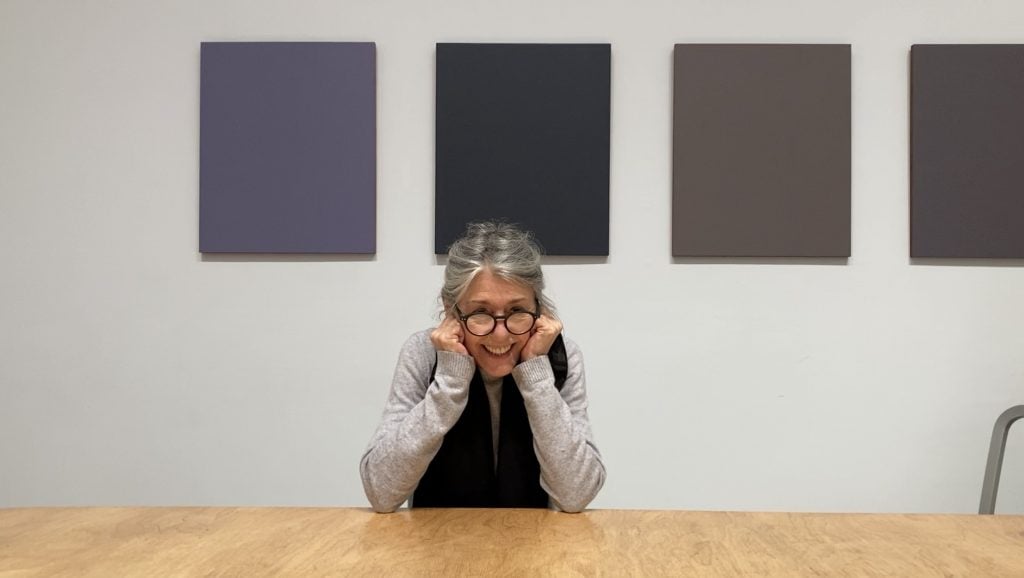
'I was dying to work for a gallery. But I had no experience, and I was very shy. The only thing I knew how to do was operate a switchboard.'

Katya Kazakina

Shoptalk is an interview series about the experiences of women art dealers and industry insiders of various generations, as told to Artnet’s Art Detective columnist Katya Kazakina. Artnet News Pro members get exclusive access—subscribe now.
At 86, art dealer Paula Cooper is a living legend, with decades of art world memories.
This month, when I sat down with Cooper to talk about her life, I was struck by her singular path and perspective. The history of 20th-century art—along with its greats—feels intimate and immediate in her recollections.
She remembers the distant and sometimes forgotten early days of key figures, before they became famous and powerful, offering spin-free insights into their journeys—and, by extension, creating a fuller and truer picture of the art world as we know it.
She remembers meeting Arne Glimcher, now the patriarch of the Pace gallery empire, when he was an art student visiting New York with his mother, who had a gallery in Boston and wanted to buy a Francis Bacon painting as her son’s wedding gift.
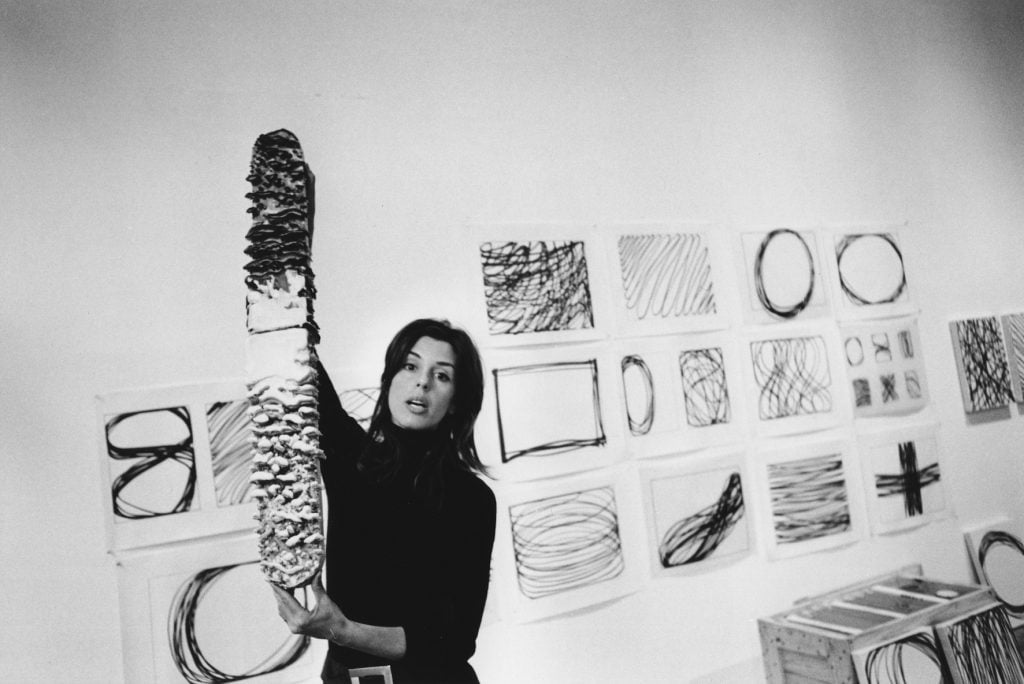
Paula Cooper holding Pinto Series 1 by Lynda Benglis, 1971. Courtesy: Paula Cooper Gallery, New York.
She remembers star artist Christopher Wool as the teenage son of Chicago collector Ira Wool, long a passionate admirer of Joel Shapiro, in whose studio the young Wool would apprentice in the early 1980s.
She remembers her distracted gallery assistant Lynda Benglis before she became a feminist icon; artist Yves Klein dressing like a “college boy”; and Joan Mitchell being “very protective” of her during a rough patch.
Cooper opened her first gallery in 1964, when she was 26, after spending a decade looking at art and working in galleries. The venture, under her maiden name, Paula Johnson, occupied a floor of an Upper East Side townhouse, where the young dealer lived with a wealthy and much older first husband. She showed works by emerging artists like Walter De Maria and Bob Thompson. Both the gallery and marriage were short-lived. “My first husband didn’t allow me to work, so I stopped being married,” she once told an interviewer.
Four years later, the Paula Cooper Gallery opened in SoHo, which was then home to many artists but not yet any galleries. Rent was cheap, and Cooper found a 10,000-square-foot, third-floor loft on Prince Street for $300 a month.

Installation view of Paula Cooper Gallery’s first exhibition, “Benefit For The Student Mobilization Committee To End The War in Vietnam,” October 22–31, 1968. Courtesy: Paula Cooper Gallery, New York.
It was 1968, a tumultuous year for the country, with assassinations of MLK and RFK, riots in Washington, D.C., and the untenable war in Vietnam. Cooper’s life was changing, too: She was married again, to music executive Neil Cooper, with a 2-year-old and another baby on the way. (They divorced in the 1980s.) The gallery’s first exhibition was a benefit against the Vietnam War, with works by Donald Judd, Carl Andre, and Sol LeWitt.
In 1996, Cooper joined a handful of intrepid dealers moving to Chelsea, where she had bought a former warehouse on West 21st Street that she converted it into an art temple that could easily accommodate the massive sculptures of Mark di Suvero.
Today, Cooper is revered as much for her early and steadfast focus on conceptual and minimal art as for her autonomy and integrity. In the age of the mega-galleries, she has eschewed global expansion, staying local with occasional pop-ups in Paris, Los Angeles, and Palm Beach.
The gallery represents 42 artists and estates, including Jennifer Bartlett, Joel Shapiro, Sol LeWitt, Jonathan Borofsky, Rudolf Stingel, Cecily Brown, and Tauba Auerbach. Even after joining bigger galleries, artists like Stingel and Shapiro have continued showing with Cooper and remained close friends.
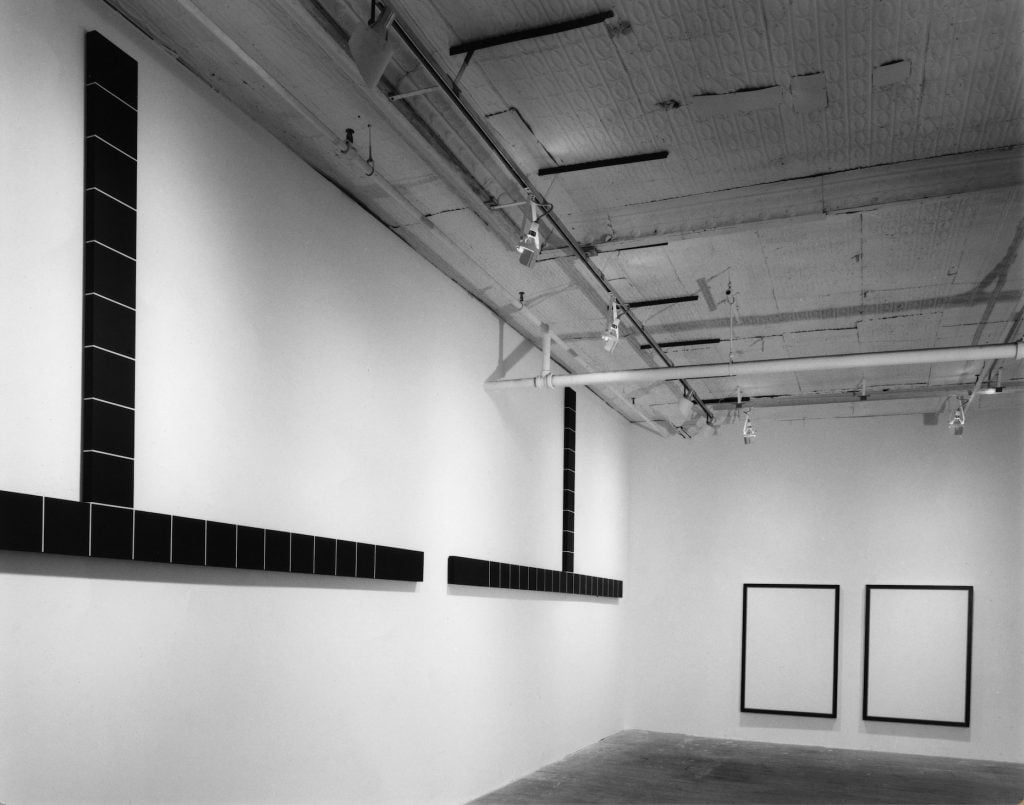
Installation view of Paula Cooper Gallery’s first exhibition, “Benefit For The Student Mobilization Committee To End The War in Vietnam,” October 22–31, 1968. Courtesy: Paula Cooper Gallery, New York.
Earlier this month, I met with Cooper—who looked chic in a crisp, white blouse and skinny grey jeans—in her airy West Chelsea apartment, filled with art, books, and monochrome flower bouquets.
She shared these elegant quarters with John Macrae III, the love of her life and her husband of 37 years, whose death in 2023 she grieves deeply. As a prominent book publisher, Macrae championed writers with the same passion and conviction that Cooper has for her artists. Together they started 192 Books, a store down the street from her gallery, where one can spot rare literary translations, the latest art monographs, and charming children’s books.
We talked for hours about her life, her gallery, and her latest challenge: Passing the baton to the next generation.
Here’s “Part I” of our edited conversation, which covers Cooper’s early path. While she’s had a clear goal from the start, getting there took years of looking and learning.
You were the first gallery to open in SoHo. What drew you to that area?
All the artists I knew lived Downtown, below Houston Street and even below Canal. I did not want “a store” or simply a space to “sell” work, a restricted space. I wanted more flexibility and freedom. I never considered Uptown. It couldn’t fulfill what I wanted to do.
You opened with a strong statement, an anti-Vietnam War exhibition. Why?
I was rabidly against the war in Vietnam. Artist Bob Huot and critic Lucy Lippard asked me if I would do that show. A lot of people came to see it. The first wall drawing that Sol LeWitt ever did was in that show. We sold two works, that’s all. Half of the money went to the artists and half of the money went to the Student Mobilization Committee to End the War in Vietnam.
How do you like that: I started the business with a show where we didn’t get any money! How could this gallery survive?!
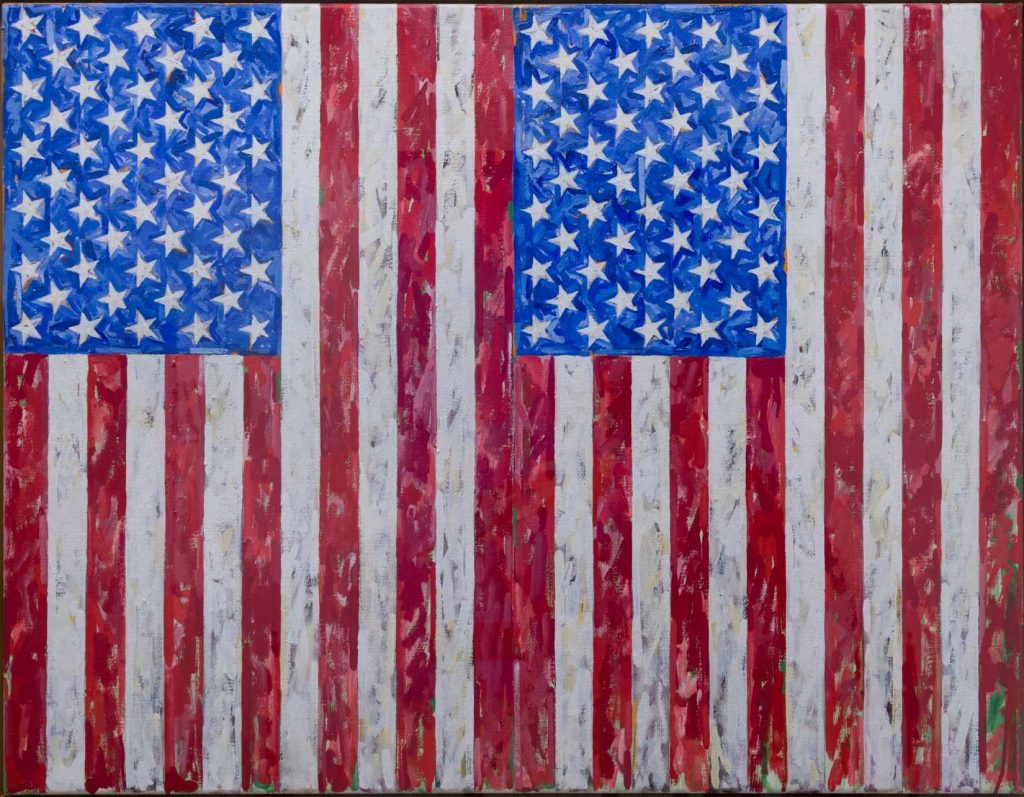
Jasper Johns, Flags (1986). Collection of Emily Fisher Landau. ©Jasper Johns.
And yet here it is 56 years later and thriving! It’s 2024, which has had many parallels with 1968. It’s the U.S. presidential election year. There’ve been student protests on university campuses. The country is divided. Next month, you are opening another political show based on artists’ responses to the American flag, organized by your senior partner, Steve Henry.
A flag is a symbol of a country that’s interpreted or used in different ways. Some are tearing it down, some are building it up, some are asking questions. Art should make people think, perhaps think differently, perhaps introduce other ideas. People should think about their country. It’s a crucial election!
What else are you working on at the moment?
We’re doing a pop-up in Shanghai this fall, with works by many artists represented by the gallery. We’ve got a charming, three-story house which will be the gallery. There’s the West Bund fair in Shanghai, which opens in early November, and we’ll open on November 6th and will be there until the 26th of December. Cara Zhuang, our Chinese director who is from Shanghai, is organizing it.
There’s a very big outdoor Mark di Suvero sculpture up in Shanghai now, beautifully installed in a park. Mark was born in Shanghai and spent the first years of his life there.

Mark di Suvero’s 51-foot-tall steel sculpture Hugs (2011), displayed at the West Bund Art Museum, Shanghai, November 2023 – 2025. © Mark di Suvero. Photo: Lawrence Lu. Courtesy: Spacetime C.C. and Paula Cooper Gallery, New York.
Let’s go back to your beginning. Where does your interest in art come from?
My mother was a passionate Sunday painter. She would have been an artist if she could. When I was little, she took art classes, so I was used to oil paint.
It was different in those days. My father worked. She was a devoted family woman. Later in life, she went to Thailand and studied art. I have pictures of her with these young male artists.
When did you realize that you wanted to become an art dealer?
I was like 17 when I decided I wanted to work with artists and to help them. I wanted to help my mother. But I didn’t have a plan. I just kept learning things. I wasn’t ambitious to do this or to do that. Things happened in their progression.
I can relate to that! How did it begin?
I was born in 1938 in Massachusetts. My father was in the Navy and I grew up from Maine to South Carolina. My grandparents were immigrants from Italy and Greece. I went to a boarding school, but not a fancy one, outside of New York City. At the time my father was stationed at the Brooklyn Navy Yard.
I finished high school in three years. Then I lived in Europe from the age of 16 for three and a half years. So, I really saw art!
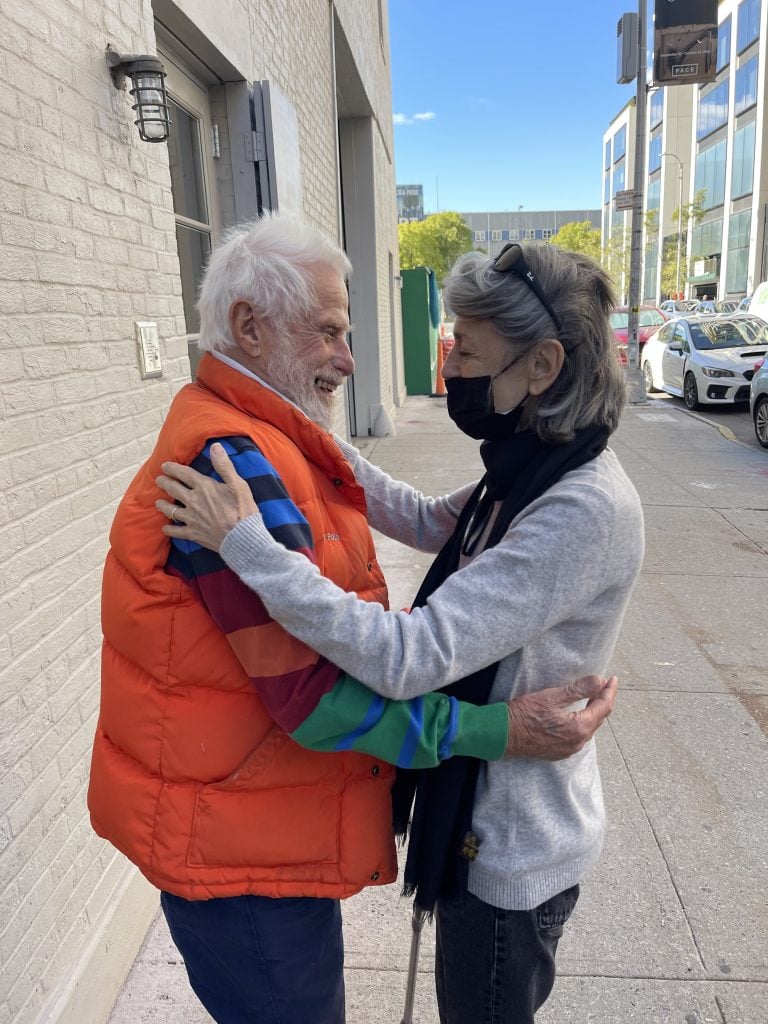
Paula Cooper with Mark di Suvero, 2022. Courtesy: Paula Cooper Gallery, New York.
Where in Europe did you live?
I lived in Athens because my father was working there for the U.S. government. I went to Pierce College for girls, the equivalent of the American College for boys. My art history teacher there was Greek, but she was from Istanbul.
Then I spent a year in Munich, and I saw Guernica there when it was traveling in Germany. I was so thrilled! The University of Maryland had a small school in Munich, so I went there my second year in Europe.
I went to Paris after Munich. Supposedly, I was going to the Sorbonne. And I did sort of go, but I spent most of my time in Paris looking at art, in galleries and the Louvre. I was very lonely there, so art was filling my life. I looked and looked. I am a great believer in looking.
When I came back to the United States, I went to Goucher, a women’s college in Baltimore. I had a very difficult time adjusting. I thought that the rules were ridiculous. But I did go to the Baltimore Museum a lot. It had beautiful Matisses and a great collection of French art, the Cone Collection.
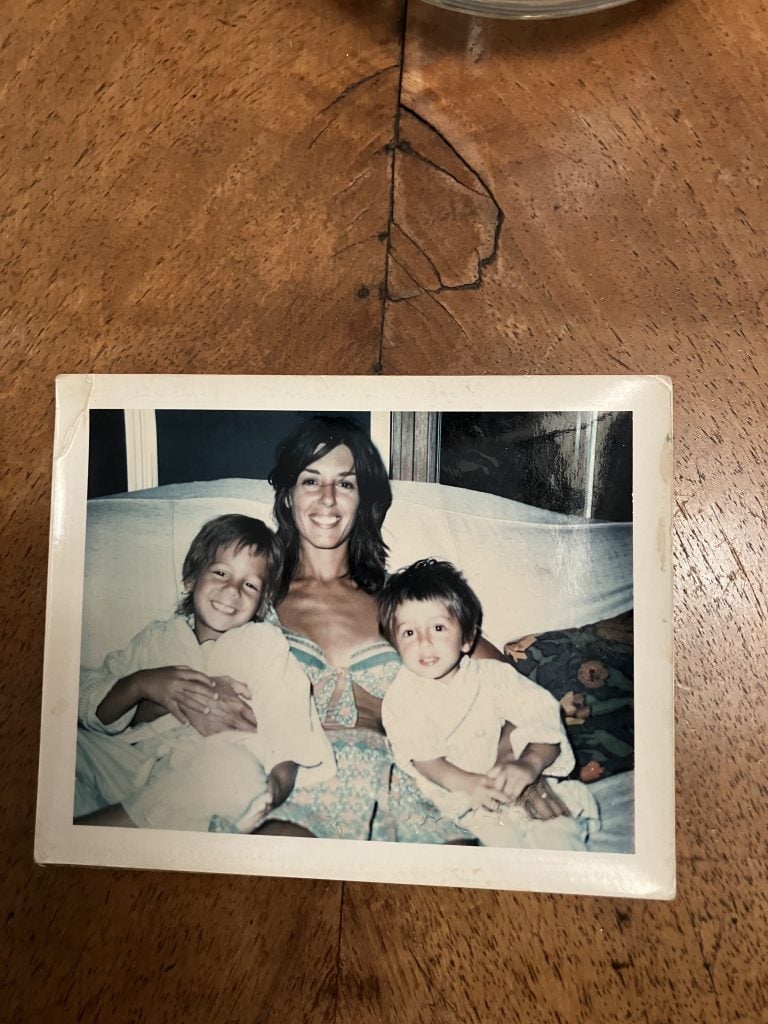
Paula Cooper with her two sons, early 1970s. Courtesy: Paula Cooper Gallery, New York.
What did you do after college?
I went to New York not knowing how to do anything. I didn’t know a soul. My parents were still abroad, and I was totally on my own.
I was dying to work for a gallery. But I had no experience, and I was very shy. The only thing I knew how to do was operate a switchboard, which I learned in boarding school. So, I got a job at Chanel as their switchboard operator.
Later, I briefly worked for a French dealer of pre-Columbian art uptown on Madison Avenue. And then at some point I worked for the Japan Society, but it wasn’t art, it was the business office. I needed a job, and I saw an ad in the newspaper. It was a very peculiar ad. It said they needed someone “quiet and calm.” So, I answered it.
What came next?
I ended up at the World House Galleries. It was in the Carlyle Hotel, designed by Frederick Kiesler, known for the Endless House and Peggy Guggenheim’s gallery.
They showed Giacometti, Dubuffet, Bacon, Morandi. It was really where I learned all the basics. I still keep records the way they kept records. My first job was just as a receptionist. I was trained to deal with clients. I also learned how to install art. The first show that was mine to install was Morandi. What a thrill!
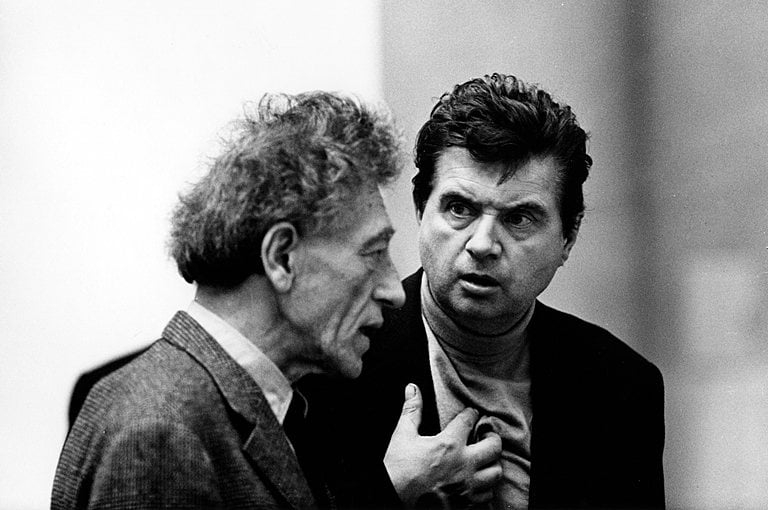
Artists Alberto Giacometti and Francis Bacon. Photo: Graham Keen / TopFoto.
To be so intimate with work, that’s the wonderful thing about being in a gallery. You see art every day. You learn how to handle it. The freedom one has! If you want to, you could put something above your desk and look at it.
It was a wonderful experience for me, and I met so many people. I met Max Ernst. A friend who worked for Castelli Gallery introduced me to Yves Klein. He was so cute. He was like a college boy the way he dressed.
And I went to Parke-Bernet auction galleries a lot because it was across the street. I thought it was so shocking the sloppy way they installed work.
My biggest thrill was selling a Giacometti to Norman Granz, a very important American music producer, who lived in Switzerland. He was rough, but what an eye! He bought this big figure of a woman.
Do you remember how much it was at the time?
It was $8,000. And then I sold a painting by Giacometti for $5,000, which was expensive compared to the sculpture. That was my big thrilling start.
It’s fascinating to me how much work you’ve done before you opened your first gallery.
It wasn’t work, it was my life! And I enjoyed most of it, except going to school. It was a very full, rich life.
Stay tuned for “Part II” of my interview with Paula Cooper, in which she slams the auction houses as “the most destructive” part of the art world and reveals what helped her navigate the ups and downs of the market over the decades. See you next week!